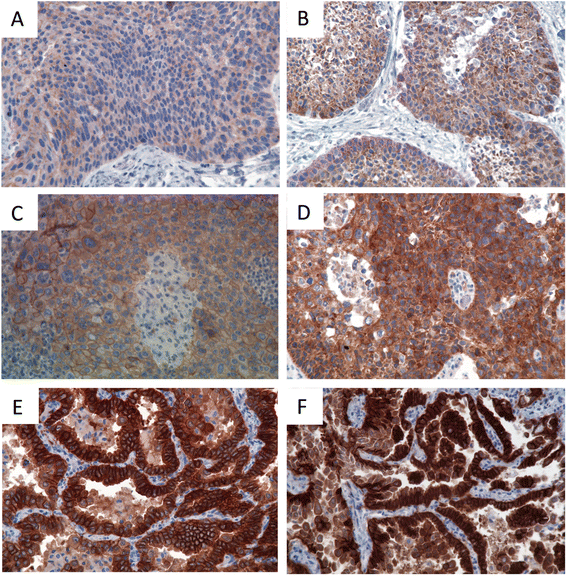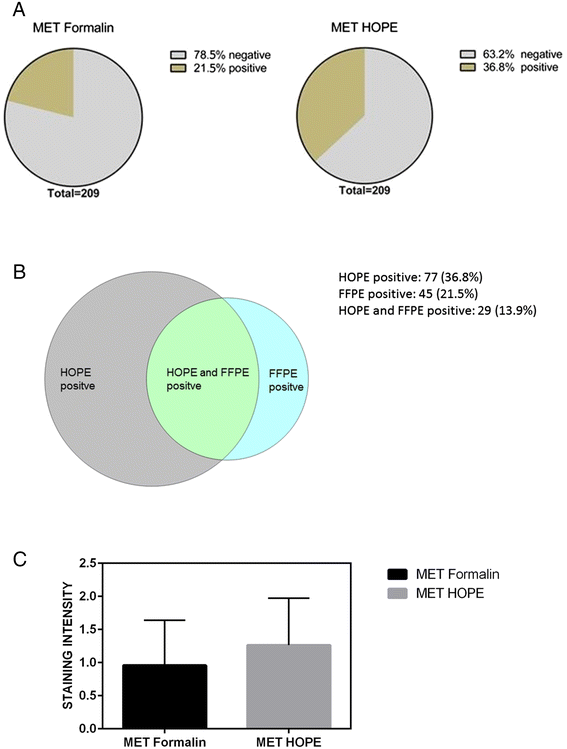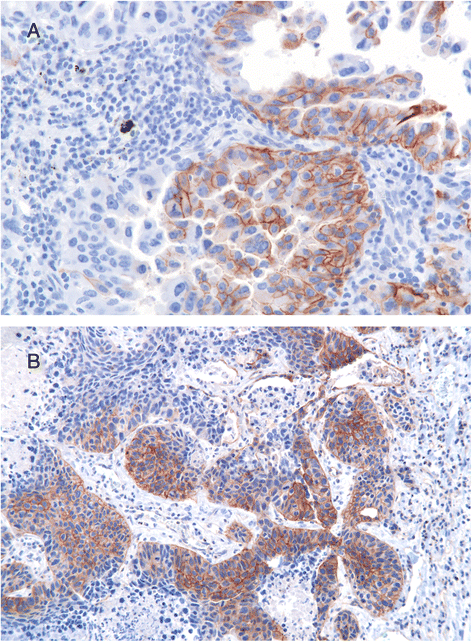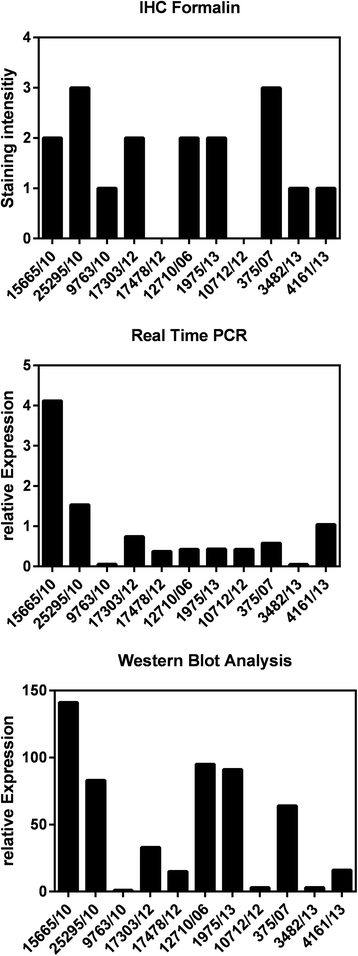Improved diagnostics targeting c-MET in non-small cell lung cancer: expression, amplification and activation?
- PMID: 26215852
- PMCID: PMC4517562
- DOI: 10.1186/s13000-015-0362-5
Improved diagnostics targeting c-MET in non-small cell lung cancer: expression, amplification and activation?
Abstract
Background: Several c-MET targeting inhibitory molecules have already shown promising results in the treatment of patients with Non-small Cell Lung Cancer (NSCLC). Combination of EGFR- and c-MET-specific molecules may overcome EGFR tyrosine kinase inhibitor (TKI) resistance. The aim of this study was to allow for the identification of patients who might benefit from TKI treatments targeting MET and to narrow in on the diagnostic assessment of MET.
Methods: 222 tumor tissues of patients with NSCLC were analyzed concerning c-MET expression and activation in terms of phosphorylation (Y1234/1235 and Y1349) using a microarray format employing immunohistochemistry (IHC). Furthermore, protein expression and MET activation was correlated with the amplification status by Fluorescence in Situ Hybridization (FISH).
Results: Correlation was observed between phosphorylation of c-MET at Y1234/1235 and Y1349 (spearman correlation coefficient rs = 0.41; p < 0.0001). No significant correlation was shown between MET expression and phosphorylation (p > 0.05). c-MET gene amplification was detected in eight of 214 patients (3.7%). No significant association was observed between c-MET amplification, c-MET protein expression and phosphorylation.
Conclusion: Our data indicate, that neither expression of c-MET nor the gene amplification status might be the best way to select patients for MET targeting therapies, since no correlation with the activation status of MET was observed. We propose to take into account analyzing the phosphorylation status of MET by IHC to select patients for MET targeting therapies. Signaling of the receptor and the activation of downstream molecules might be more crucial for the benefit of therapeutics targeting MET receptor tyrosine kinases than expression levels alone.
Figures





Similar articles
-
Synergistic Activation upon MET and ALK Coamplification Sustains Targeted Therapy in Sarcomatoid Carcinoma, a Deadly Subtype of Lung Cancer.J Thorac Oncol. 2016 May;11(5):718-728. doi: 10.1016/j.jtho.2016.01.009. Epub 2016 Jan 22. J Thorac Oncol. 2016. PMID: 26804638
-
Targeting the MET gene for the treatment of non-small-cell lung cancer.Crit Rev Oncol Hematol. 2014 Feb;89(2):284-99. doi: 10.1016/j.critrevonc.2013.11.006. Epub 2013 Dec 1. Crit Rev Oncol Hematol. 2014. PMID: 24355409 Review.
-
Crizotinib with or without an EGFR-TKI in treating EGFR-mutant NSCLC patients with acquired MET amplification after failure of EGFR-TKI therapy: a multicenter retrospective study.J Transl Med. 2019 Feb 21;17(1):52. doi: 10.1186/s12967-019-1803-9. J Transl Med. 2019. PMID: 30791921 Free PMC article.
-
Inhibition of ABCB1 Overcomes Cancer Stem Cell-like Properties and Acquired Resistance to MET Inhibitors in Non-Small Cell Lung Cancer.Mol Cancer Ther. 2015 Nov;14(11):2433-40. doi: 10.1158/1535-7163.MCT-15-0050. Epub 2015 Sep 8. Mol Cancer Ther. 2015. PMID: 26351321
-
The c-Met inhibitors: a new class of drugs in the battle against advanced nonsmall-cell lung cancer.Curr Pharm Des. 2012;18(37):6155-68. doi: 10.2174/138161212803582478. Curr Pharm Des. 2012. PMID: 22873759 Review.
Cited by
-
Correlation between Programmed Death Ligand-1(PD-L1) Expression and Driver Gene Mutations in Non-Small Cell Lung Carcinoma- Adenocarcinoma Phenotype.Asian Pac J Cancer Prev. 2022 Jan 1;23(1):131-142. doi: 10.31557/APJCP.2022.23.1.131. Asian Pac J Cancer Prev. 2022. PMID: 35092381 Free PMC article.
-
MET-dependent solid tumours - molecular diagnosis and targeted therapy.Nat Rev Clin Oncol. 2020 Sep;17(9):569-587. doi: 10.1038/s41571-020-0377-z. Epub 2020 Jun 8. Nat Rev Clin Oncol. 2020. PMID: 32514147 Free PMC article. Review.
-
Targeting MET Dysregulation in Cancer.Cancer Discov. 2020 Jul;10(7):922-934. doi: 10.1158/2159-8290.CD-19-1446. Epub 2020 Jun 12. Cancer Discov. 2020. PMID: 32532746 Free PMC article. Review.
-
The role of c-MET inhibitors in advanced hepatocellular carcinoma: now and future.Ann Transl Med. 2020 Dec;8(23):1617. doi: 10.21037/atm-20-3387. Ann Transl Med. 2020. PMID: 33437816 Free PMC article. No abstract available.
-
MET Alterations in Cancer and MET-Targeted Therapy: Detection Strategies, Treatment Efficacy, and Emerging Technologies.Target Oncol. 2025 Jul 18. doi: 10.1007/s11523-025-01166-0. Online ahead of print. Target Oncol. 2025. PMID: 40679792 Review.
References
Publication types
MeSH terms
Substances
LinkOut - more resources
Full Text Sources
Other Literature Sources
Medical
Molecular Biology Databases
Research Materials
Miscellaneous

